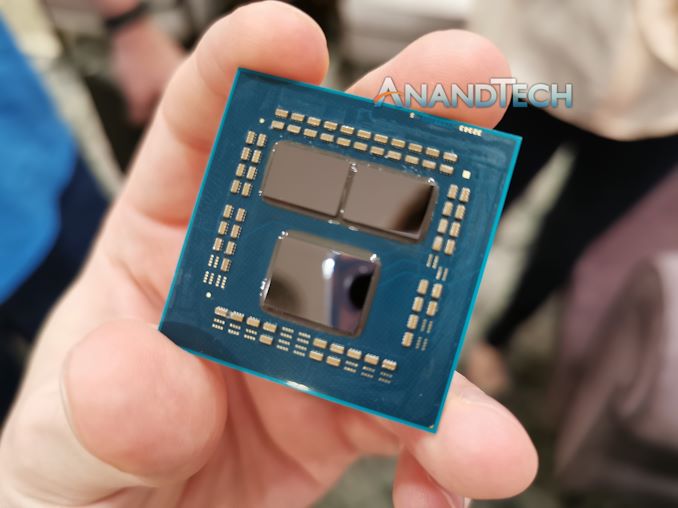Reaching for Turbo: Aligning Perception with AMD’s Frequency Metrics
by Dr. Ian Cutress on September 17, 2019 10:00 AM EST
For those that keep a close eye on consumer hardware, AMD recently has been involved in a minor uproar with some of its most vocal advocates about the newest Ryzen 3000 processors. Some users are reporting turbo frequencies much lower than advertised, and a number of conflicting AMD partner posts have generated a good deal of confusion. AMD has since posted an update identifying an issue and offering a fix, but part of all of this comes down to what turbo means and how AMD processors differ from Intel. We’ve been living on Intel’s definitions of perceived standards for over a decade, so it’s a hard nut to crack if everyone assumes there can be no deviation from what we’re used to. In this article, we’re diving at those perceived norms, to shed some light on how these processors work.
A Bit of Context
Since the launch of Zen 2 and the Ryzen 3000 series, depending on which media outlet you talk to, there has been a peak turbo issue with the new hardware. This turbo frequency issue has been permeating in the ecosystem since Zen 2 was launched, with popular outlets like Gamers Nexus noting that on certain chips, the advertised turbo frequency was only achieved under extreme cooling conditions. For other outlets, being within 50 MHz of the peak turbo frequency has been considered chip-to-chip variation, or a function of early beta firmware. A wide array of people put varying amounts of weight behind this, from conspiracy to not being bothered about it at all.
However, given recent articles by some press, as well as some excellent write-ups by Paul Alcorn over at Tom’s Hardware*, we saw that the assumed public definitions of processor performance actually differs from Intel to AMD. What we used as the default standard definitions, which are based on Intel’s definitions, are not the same under AMD, which is confusing everyone. No one likes a change to the status quo, and even with articles out there offering a great breakdown of what's going on, a lot of the general enthusiast base is still trying to catch up to all of the changes.
This confusion – and the turbo frequency discussion in general – were then brought to the fore of news in the beginning of September 2019. AMD, in a two week span, had several things happen essentially all at once.
- Popular YouTuber der8aur performed a public poll of frequency reporting that had AMD in a very bad light, with some users over 200 MHz down on turbo frequency,
- The company settled for $12.1m in a lawsuit about marketing Bulldozer CPUs,
- Intel made some seriously scathing remarks about AMD performance at a trade show,
- AMD’s Enterprise marketing being comically unaware of how its materials would be interpreted.
Combined with all of the drama that the computing industry can be known for – and the desire for an immediate explanation, even before the full facts were in – made for a historically bad week for AMD. Of course, we’ve reported on some of these issues, such as the lawsuit because they are interesting factoids to share. Others we ignored, such as (4) for a failure to see anything other than an honest mistake given how we know the individuals behind the issues, or the fact that we didn’t report on (3) because it just wasn’t worth drawing attention to it.
What has driven the discussion about peak turbo has come to head because of (1). Der8auer’s public poll, taken from a variety of users with different chips, different motherboards, different cooling solutions, different BIOS versions, still showed a real-world use case of fewer than 6% of 3900X users were able to achieve AMD’s advertised turbo frequency. Any way you slice it, without context, that number sounds bad.
Meanwhile, in between this data coming out and AMD’s eventual response, a couple of contextual discrepancies happened between AMD’s partner employees and experts in the field via forum posts. This greatly exacerbated the issue, particularly among the vocal members of the community. We’ll go into detail on those later.
AMD’s response, on September 10th, was a new version of its firmware, called AGESA 1003-ABBA. This was released along with blog post that detailed that a minor firmware issue was showing 25-50 MHz drop in turbo frequency was now fixed.
Naturally, that doesn’t help users who are down 300 MHz, but it does come down to how much the user understands how AMD’s hardware works. This article is designed to shed some light on the timeline here, as well as how to understand a few nuances of AMD's turbo tech, which are different to what the public has come to understand from Intel’s use of specific terms over the last decade.
*Paul’s articles on this topic are well worth a read:
Ryzen 3000, Not All Cores Are Created Equal
Investigating Intel’s Claims About Ryzen Reliability
Testing the Ryzen 3000 Boost BIOS Fix
This Article
In this article we will cover:
- Intel’s Definition of Turbo
- AMD’s Definition of Turbo
- Why AMD is Binning Differently to Intel, relating to Turbo and OC
- A Timeline of AMD’s Ryzen 3000 Turbo Reporting
- How to Even Detect Turbo Frequencies
- AMD's Fix











144 Comments
View All Comments
Korguz - Thursday, September 19, 2019 - link
so i guess you are ok with intel marketing their chips to only use the watts they state, but under real usage, they can, specially when overclocked, they can use MUCH more ??Cooe - Tuesday, March 23, 2021 - link
It doesn't say "4.7GHz Turbo" it says "Max 4.7GHz Turbo". Aka "UP TO!". It's not AMD's fault if "Average Joe" literally doesn't know how to read...Oliseo - Wednesday, September 18, 2019 - link
Also, if YOU have to write a multi page highly technical article on why AMD is right and all the customers are wrong, then you're just a fanboy who doesn't give a **** about the customer.We get enough of this in the comments with people in the media joining in to make excuses for large multinationals at the expense of the average consumer.
Shame on you!
eva02langley - Wednesday, September 18, 2019 - link
Here, these people will escort you to your new home, the asylum... cheers and enjoy you stray jacket...Calabros - Wednesday, September 18, 2019 - link
This the funniest First World Problem I've seen in 2019.regsEx - Wednesday, September 18, 2019 - link
I can't find any reference in CFL documentation that PL1 is for base clocks. It doesn't seem to have any correlation.edzieba - Wednesday, September 18, 2019 - link
Sounds like the "Intel Performance Maximizer" is exploring and characterising the frequency-space above the all-core turbo clock. That could be done at the factory to provide faster out-of-the-box performance, but would either introduce chip-to-chip variation is stock (rather than OC) performance, or create even more SKU bins. And people already throw a wobbler over he number of SKUs Intel produce (even though 90% of those are not a consideration unless you order direct from them in $multimillion batches).samboy - Wednesday, September 18, 2019 - link
My biggest concern is for the 3950x.This has the highest Turbo specification of all the processors; which was a good selling point when I first saw the specifications
However, it is becoming clear that the all-core base clock speed specification is more important. Particularly given that the 3900x seems to take the least "advantage" of Turbo out of all the current chips.
Comparing the specifications of 3950x to 3900x we see a 300MHZ drop off on base core speed; in exchange for an extra 100MHZ in boost - which seems somewhat questionable now.
A 50% increase in cost for an extra 4 cores and likely slower throughput for tasks that use 12 or less cores (which covers almost everything that is run in practice today) this doesn't look like particularly good value. My untested assumption is that the 300MHZ less in base speed is the more important number and will translate to slower throughput.
I'll wait for the reviews for the 3950x; but I expect that I'll be leaning for the 3900x for the second system I need to build.
oleyska - Wednesday, September 18, 2019 - link
3900X boosts higher than any other ryzen chip out today.I think 3950X will be faster than 3900X, on ryzen amount of cores doesn't matter at all.
Have a ryzen 1700? it isn't at all limited in comparison to a 1600 and on average seems to hit higher frequencies and it's absolutely true for 3000 series, even More so!
ajlueke - Thursday, September 19, 2019 - link
"A 50% increase in cost for an extra 4 cores and likely slower throughput for tasks that use 12 or less cores (which covers almost everything that is run in practice today) this doesn't look like particularly good value."The 3950X will almost certainly be faster than the 3900X in just about every scenario. If you consider the way the two chiplet CPUs are binned, they have one fast chiplet (CCD) and one that is not nearly as fast.
In the 3900X these CCDs are 6 cores each, while they are 8 cores in the 3950X. Which means in an 8 thread workload, the 3950X can do that entire workload on the "better" CCD0, which should have a better frequency/voltage curve. The 3900X will have to dip into 2 cores on CCD1. The 12 core workload is a similar story, the overall frequency/voltage curve will be better on the 3950X because it is boosting more "better" binned cores than the 3900X with the same power envelop.